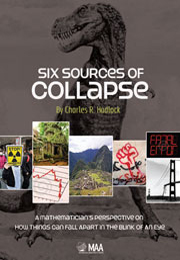 Six Sources of Collapse
Six Sources of Collapse Book contents
- Frontmatter
- Preface
- Acknowledgements
- Contents
- 1 Introduction
- 2 Predicting Unpredictable Events
- 3 Group Behavior: Crowds, Herds, and Video Games
- 4 Evolution and Collapse: Game Playing in a Changing World
- 5 Instability, Oscillation, and Feedback
- 6 Nonlinearity: Invitation to Chaos and Catastrophe
- 7 It's All About Networks
- 8 Putting It All Together: Looking at Collapse Phenomena in “6-D”
- References
- Index
- About the Author
5 - Instability, Oscillation, and Feedback
- Frontmatter
- Preface
- Acknowledgements
- Contents
- 1 Introduction
- 2 Predicting Unpredictable Events
- 3 Group Behavior: Crowds, Herds, and Video Games
- 4 Evolution and Collapse: Game Playing in a Changing World
- 5 Instability, Oscillation, and Feedback
- 6 Nonlinearity: Invitation to Chaos and Catastrophe
- 7 It's All About Networks
- 8 Putting It All Together: Looking at Collapse Phenomena in “6-D”
- References
- Index
- About the Author
Summary
Sharing an electric blanket and other challenges
I happen to have a lot of experience with electric blankets. It comes from owning that old unheated New Hampshire summer getaway I've mentioned earlier, and from making an occasional winter foray into it on snowshoes to see if it's still standing and to retrieve one or another forgotten item. The best way to survive the night there in freezing conditions (both inside and out) is to turn on an electric blanket several hours before getting into the bed and letting things warm up a bit. But invariably, when you get into the bed and lie there for a while, you find that some adjustment of the temperature control is needed. If it's too high, you wake up sweating to death, and if it's not high enough, you wake up wondering why you decided to torture yourself by staying overnight. With adjustments during a single night or a setting based on experience gained over several years, it's not too hard to find a “stable equilibrium setting that keeps things at or close to a comfortable, constant temperature. Fine so far.
The situation is slightly more complicated when my wife accompanies me as we prefer somewhat different temperature settings for the blanket. Thus there have been occasional middle-of-the-night adjustments by one or the other of us to suit our own tastes, hoping that the other person is sufficiently sound asleep not to notice.
- Type
- Chapter
- Information
- Six Sources of CollapseA Mathematician's Perspective on How Things Can Fall Apart in the Blink of an Eye, pp. 85 - 120Publisher: Mathematical Association of AmericaPrint publication year: 2012
